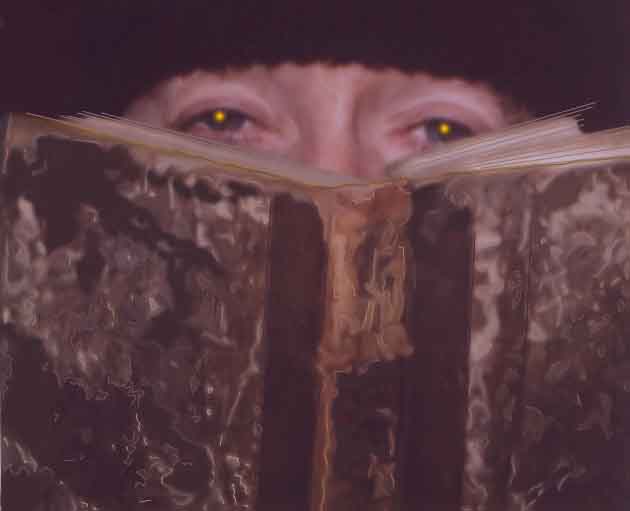









THE PAINTER'S NEWFOUNDLAND
Organized by the Pouch Cove Foundation and the James Baird Gallery, St. John's, assisted by the Art Gallery of Newfoundland & Labrador (February 15 - April 12, 1998)
[First published in Winnipeg's Border Crossings magazine as "See Change." issue 73, 2000, 62-63.]
This exhibition was produced by Newfoundland art dealer James Baird, who for some time has invited painters, mostly from outside Newfoundland, to make art in a small seaside house he owns in Pouch Cove, not thirty minutes from St. John's. Not all Pouch Cove visitors are landscape painters--or even painters; this show includes only self-selected contributions from a Baird-selected group. The artists rose to Baird's challenge, and the results, with a few exceptions, are worth a first, second and third look.
I had assumed that much of the work might address, even if obliquely, issues of ethnicity and land that are contested so hotly within Newfoundland culture: those "come-from-away" and "we were here first" issues. The contemporary art of Newfoundland, as these mostly visiting artists may know, is as much preoccupied with property and history as the contemporary art of ex-Yugoslavia and Northern Ireland, so how would artists from outside respond to Newfoundland's mental landscapes?
Bill Rose, who with Sharon Puddester is one of only two Newfoundlanders in the exhibition, stenciled the question "What are you looking at?" across one of his seascapes and "Disaffection is Rife" across another. Non-Newfoundlander David Alexander's "Petunias Hiding the Matthew at Twillingate" makes reference to the replica of John Cabot's discovery ship during last year's 500th anniversary celebrations. Was Rose's question meant for outsiders like Alexander? Was non-Newfoundlander Alex Cameron's "John Cabot Celebrations" an answer to Rose's question? Alexander's petunias obscure the Matthew, as the title suggests, and Alex Cameron's fireworks are slowed down to a crawl by a clogged paint surface. Each made risky references to the local division of opinion about whether Cabot should be celebrated at all; both, with twists, looked at the land and sea with an ambivalence absent from official recent portrayals.
Questions of cultural ownership may be interesting, but I couldn't get the fortuitous timing of this exhibition with the release of the movie "Titanic" out of my mind. A Newfoundland iceberg took the Titanic down, many Newfoundlanders will proudly tell you, and there are plenty of icebergs in this show. (Even Wayne Boucher's iceberg-free "Keep Clear of Me, I am Having Difficulty Maneuvering" (1997) had me thinking icebergs.) Brent McIntosh applied abstract expressionist marks like a half-tone dot screen over his iceberg. This effect seemed arbitrary to me because the the surface looked unfelt. Dan Hudson's icebergs suffered from graphic design: the images overlap or are buttressed as if to mimic the composition of a magazine page. I wanted Hudson to show in his painting why his paintings should be put together this way.
I may not have liked the McIntosh and Hudson works, but my ugly iceberg award goes to David Bierk's "Locked in Migration (Church), to Dennis," a heavily varnished and artificially cracked oil on board with steel work in which a setting sun plays off an iceberg through the sails of a vintage fishing schooner. Frederic Church was a nineteenth-century American who painted Newfoundland's icebergs in a Romantic style--is Bierk's pastiche meant to be a tribute?
I'll take the understated and tasteful black and white iceberg watercolours by David Bolduc to Bierk's historicizing conceits any day. John Hartman's "Foxtrap" is a fluid and breathtaking bird's eye view of a Newfoundland seaside village, a magnificent painting, full of air and sea and sky. (Hartman, by the way, is one of the only artists to include the suggestion of figures in his landscape--cars and houses, too. Why so many empty landscapes?)
There are many other beautiful paintings in this show. Susanna Heller's "Those Lips and Rocky Coastline" is a lumpy, gray, expressionistic tour-de-force. I liked Wanda Koop's iridescent "Newfoundland " series, in which silver frames set off bronze and mat silver colour. Diane Whitehouse asserted her English roots in Constable-inspired studies of sea and sky named after the days of the week. Brian Kipping and Newfoundlander Sharon Puddester contributed understated settlement scenes ( however, Puddester's gouged wood landscapes depicted not Pouch Cove, but the Norse settlement at Lance aux Meadows, which is 600 miles away from Baird's village). Jennifer Stead's "Cape St. Francis" slowed down my viewing as I puzzled out its technical beauties. Medrie MacPhee's cubist mixed media painting, Wayne Boucher's saturated blue canvas, and Michael Smith's two panel abstraction provided welcome hits of pure colour in a show devoted mostly to various representational styles.

|
|